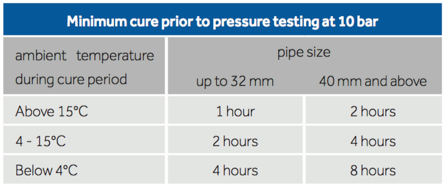How To Install FlowGuard® CPVC In Hot Weather
One of the advantages of the CPVC installation process is that it can be done in hot or cold temperatures. While the FlowGuard® Installation Guide provides step-by-step instructions on how to properly install CPVC piping for plumbing systems, contractors should take the following special considerations when installing FlowGuard pipe and fittings in hot temperatures.
By following these simple guidelines, reliable solvent welds can be formed in temperatures exceeding 35°C.
Solvent Welding CPVC
Heat can increase how quickly the solvents within the solvent cement evaporate. Pipe and fittings should only be joined while the solvent cement is wet, otherwise a reliable seam won’t be created. This effect is compounded in arid environments.
To ensure a strong seam in hot, arid areas, consider the following:
- Join seams in cooler areas or shade.
- Heat can increase how quickly solvent cement evaporates. Pipe and fittings should only be joined while the solvent cement is wet. If the solvent cement dries before the pipe and fittings are joined together, either cut the section where the solvent cement was applied or remove the residual with sandpaper and start the solvent cement process again.
An advantage of using solvent cement in warm weather is cure times are much quicker, so systems can be installed and pressure tested sooner.

Account for Thermal Expansion
As with all materials, CPVC will expand and contract as the temperature fluctuates. This is especially true for Saudi Arabia where temperatures can reach upwards of 54°C during summer days and drop considerably over night.
Installers should always account for the temperature change a pipe will be exposed to from the moment of installation throughout its life. This includes both environmental factors as well as cold and hot water flowing through they system.
For more info on accounting for thermal expansion and contraction in plumbing system pipes, check out this blog post.
Proper Storage and Handling
Outside of some exterior discoloration, FlowGuard CPVC piping won’t experience any negative effects from being exposed to direct sunlight.
It is highly suggested to keep the piping out of the elements and away from exposure to weather. Ideally CPVC pipe and fittings are stored indoors, under a non-transparent material.
For solvent cement, follow the label for storing instructions.
Advantages of CPVC in Hot Weather Applications
CPVC performs exceptionally well in hot weather applications.
Since solvent cement dries quicker in high heat, piping systems become faster to install, saving time and money. This creates a more reliable and durable piping system for residential plumbing applications.
To learn more about installing a FlowGuard CPVC plumbing system in high heat environments, contact our team of piping systems consultants.
.png)
-1.png)